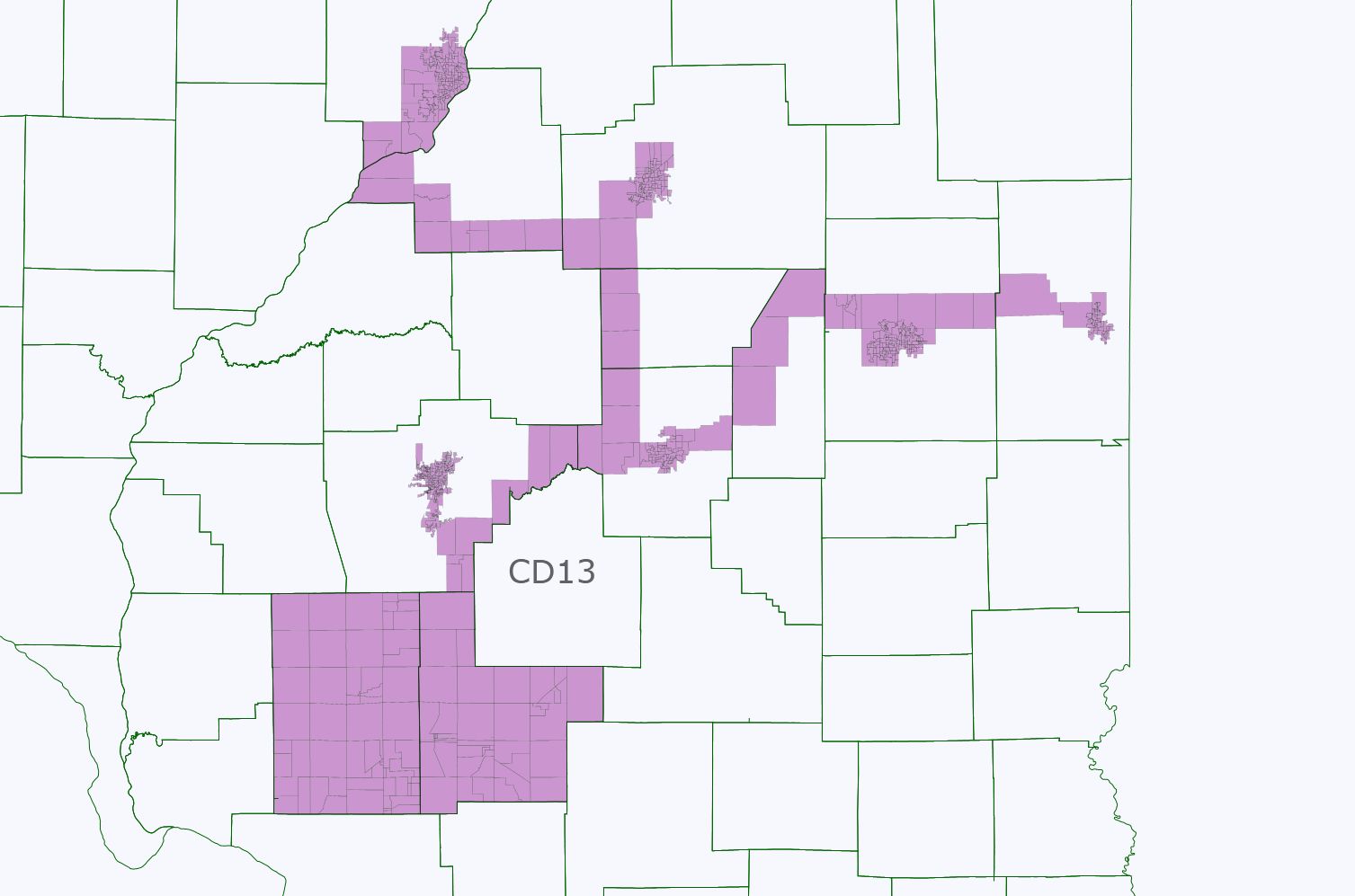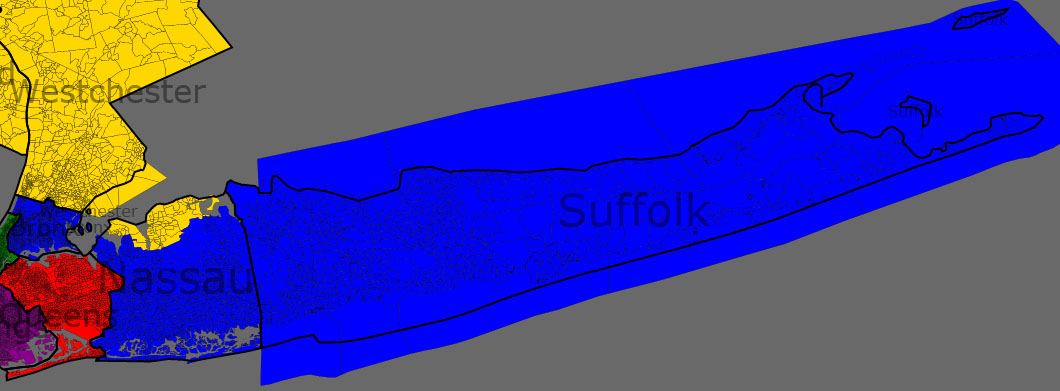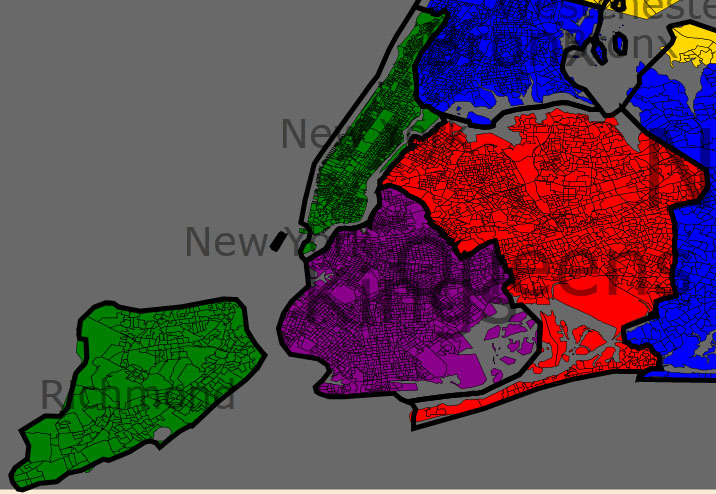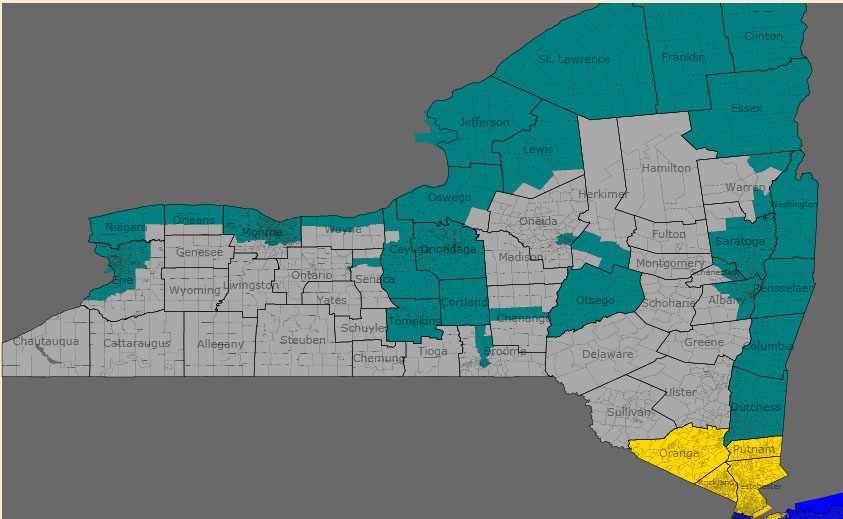My goals going into this were:
1.) To make sure the new district elects a Democrat.
2.) To shore up the three Central/Southern Georgia Democrats (especially Marshall and Barrow), not only for the incumbents but also Democrats in general if and when those seats come open.
3.) To create or expand our bench in our districts.
4.) To fuck with Phil Gingrey and John Linder to the best of my ability.
5.) To try my best not create an ode to the Flying Spaghetti Monster.
To that end, I think I accomplished these goals. My maps:

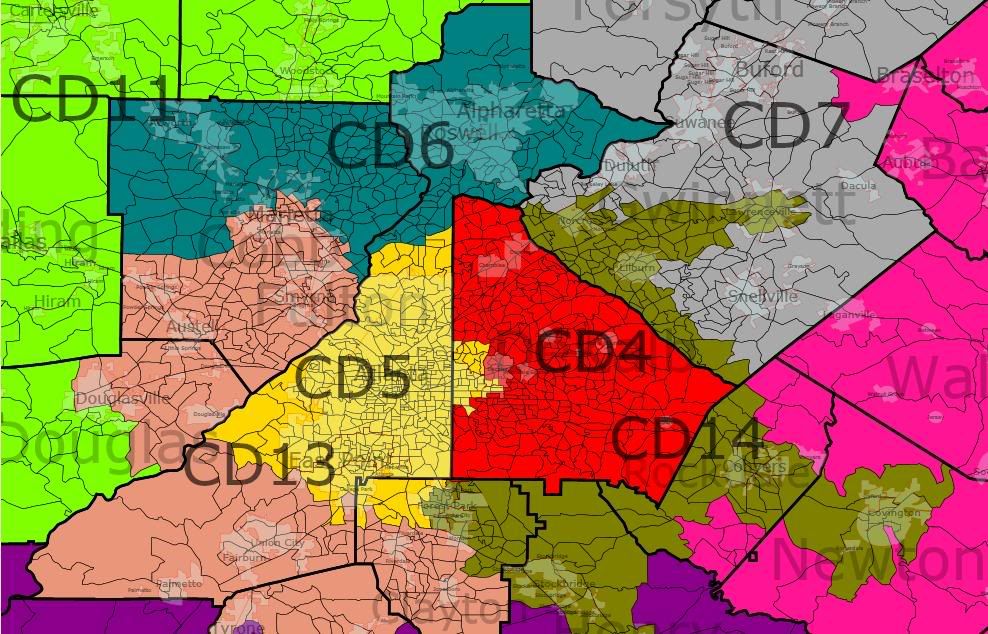
Atlanta Metro Area
1st District (Jack Kingston [R]) BLUE
New Demographics: 71.3% white | 20.8% black | .3% Native American | 1.1% Asian | 5.4% Hispanic | .1% other
Old Demographics: 72.8% white | 21.2% black | .2% Native American | .9% Asian | 3.9% Hispanic | 1% other
Old District: 72.6% white | 22.7% black | .3% Native American | .9% Asian | 4.1% Hispanic | .2% other
I used this as a dumping ground for Republican votes from the 8th and 12th districts while trying to remove Democratic areas for use in those districts. Kingston gains several Republican counties to the north from the 12th, including much of Effingham County exchange for heavily Democratic Liberty County, some black(er) areas in McIntosh County as well as connectors in Chatham County. He also picks up much of heavily Republican Laurens County as well as other parts from the 8th. Surprisingly, the district gets a bit more diverse (and even more surprisingly, from Asians, Hispanics, and Native Americans), but don't hold your breath; it's a very small increase. Kingston will win in a cakewalk; our bench in the district is non-existent, at least at the state legislature-level.
2nd District (Sanford Bishop [D]) GREEN
New Demographics: 48.4% white | 45.2% black | .3% Native American | .8% Asian | 4.3% Hispanic | 1% other
Old Demographics: 49.7% white | 45.1% black | .3% Native American | .6% Asian | 3.3% Hispanic | .9% other
Old District: 51.4% white | 44.8% black | .3% Native American | .6% Asian | 3.5% Hispanic | .1% other
With some minor scandal involving Bishop and rumors of an adminstration post, I felt the need to shore up his district a bit, considering Bush won it in 2004. Population loss/stagnation and losses of area to the 8th necessitated moving the district northward, taking up more of Columbus, as well as extending up to take on the swingy Meriwether County plus the heavily black parts of Troup County in and around LaGrange. Essentially, I added state Rep. Carl von Epps' district. This also helped offset the addition of very Republican Colquitt County. The district goes from majority white to plurality white and is trending even more minority. Bishop should have no trouble and his successor should be in a relatively good position.
3rd District (Lynn Westmoreland [R]) PLUM
New Demographics: 71.3% white | 20.8% black | .3% Native American | 1.1% Asian | 5.4% Hispanic | .1% other
Old Demographics: 79% white | 16.6% black | .3% Native American | 1.1% Asian | 2% Hispanic | 1% other
Old District: 72.6% white | 22.7% black | .3% Native American | .9% Asian | 4.1% Hispanic | .2% other
The 3rd loses more of Muscogee County /Columbus to the 2nd and some of its Metro Atlanta area but now goes to the Macon area, making it more of a Central Georgia district. Other than the peninsulas from the 2nd district, it's actually more compact than before. This area has diversified at a pretty good clip, but even running 80 MPH takes a long time when you're driving from New York to Los Angeles. Plus, it's still demographically very similar to Westmoreland's old district. Looks like we would have to deal with his “uppity” ass for a while.
4th District (Hank Johnson [D]) RED
New Demographics: 29.9% white | 53.4% black | .2% Native American | 4.3% Asian | 10.8% Hispanic | 1.2% other
Old Demographics: 31.3% white | 54.3% black | .2% Native American | 4.1% Asian | 8.1% Hispanic | 2% other
Old District: 35.8% white | 53.5% black | .4% Native American | 4.3% Asian | 8.5% Hispanic | 0% other
I undid the horrendous four-way cracking of DeKalb, replacing it with a two-way split. The fourth occupies the overwhelming majority of DeKalb, having been moved completely out of Gwinnett and Rockdale Counties and absorbing DeKalb areas from the 5th, 6th, and 13th. Even though North DeKalb is pretty white, the additions from Central and South DeKalb more than make up for it. The district gets a little less black but even more minority than before. Hank Johnson will win easily.
5th District (John Lewis [D]) YELLOW
New Demographics: 29.9% white | 57.9% black | .2% Native American | 2.8% Asian | 8.2% Hispanic | 1% other
Old Demographics: 31.2% | 59.6% black | .2% Native American | 2% Asian | 5.7% Hispanic | 1.3% other
Old District: 37% white | 56.1% black | .2% Native American | 2.2% Asian | 6.1% Hispanic | 0% other
Pretty similar to its current form, especially in Clayton and Fulton Counties. It's still an Atlanta plus some inner-ring suburbs districts, taking in slighly less of Forest Park and South Fulton but a bit more of unincorporated Clayton and a bit more of Sandy Springs. The big difference is it being reducing to about 45% of it's DeKalb area, including its portion of Decatur, and is basically left with the DeKalb portion of Atlanta plus some areas northeast of this area. John Lewis has nothing to worry about.
6th District (Tom Price [R] vs. Phil Gingrey [R]) TEAL
New Demographics: 75.3% white | 9% black | .3% Native American | 6.3% Asian | 7.7% Hispanic | 1.5% other
Old Demographics: 80.6% white | 7.9% black | .2% Native American | 4.3% Asian | 5.1% Hispanic | 1.8% other
Old District: 85.6% white | 7% black | .2% Native American | 4% Asian | 4.5% Hispanic | .1% other
This is one of my “fuck with the Republicans” districts. Like before, the district includes white, affluent, Republican North Fulton County (including Tom Price's home) and East Cobb (likewise white, affluent, and Republican). However, instead of going east to take up North DeKalb County and north to pick up Cherokee County, it goes west to take up the northern half of Cobb County. In the general election, this doesn't mean anything; it's still a heavily white, Republican district in which we have no bench (although there is some diversification and it now includes a major state university). However, the district now includes Phil Gingrey's home between Kennesaw and Marietta!
7th District (John Linder [R] vs. ?) GRAY
New Demographics: 68.1% white | 10.8% black | .3% Native American | 6.1% Asian | 13.5% Hispanic | 1.2% other
Old Demographics: 79% white | 6.8% black | .2% Native American | 3.9% Asian | 8.7% Hispanic | 1.3% other
Old District: 85.2% white | 7.1% black | .3% Native American | 3.8% Asian | 5.4% Hispanic | .1% other
Same thing with as with the 6th. Linder loses more of the diverse areas of Gwinnett County to the 14th, as well as the Newton, Walton, and Barrow County portions. In return, he gains almost all of Forsyth County and the Southern half of Hall County. Depending on who wins the Republican primary in the current 9th district, this may set up a primary in this new 7th. Regardless, this will be a Republican seat for the foreseeable future. However, it's rapidly diversifying with every minority group taking up a larger share than before. I think Linder's days are numbered. It may be a fairly big number, but numbered all the same.
8th District (Jim Marshall [D]) PERIWINKLE
New Demographics: 54.2% white | 40% black | .2% Native American | 1.1% Asian | 3.6% Hispanic | 1% other
Old Demographics: 55.6% white | 39.8% black | .2% Native American | .8% Asian | 2.6% Hispanic | 1% other
Old District: 64% white | 32.6% black | .2% Native American | .8% Asian | 2.8% Hispanic | 1.4% other
Basically, I shifted the district southward and worked to make sure it was more favorable on a presidential level in anticipation of Marshall's eventual departure for higher office. So, this meant I had to cut almost all of Laurens County out of the district. Marshall won it big, but Obama lost it big, and Marshall performed less strikingly there in the past. I regrettably had to remove Dem-trending Newton County from the district, but the benefit from having it in the district was outweighed by the cost of having four heavily Republican counties in the district to connect Newton to the rest of the district, especially considering Marshall only barely won Newton and lost it in 2006. While I was at it, I also cut out the whiter parts of Bibb County. I also removed the troublesome Colquitt County, home of Saxby Chambliss and added a few blue and purple counties along the boomerang. I also shifted down to add Valdosta, thus increasing our bench as all four members of the state legislature from this area are Democrats. I would have liked to have removed the more Republican parts of Houston County, but I don't know where I'd make up the lost population, but, overall, I think I made Marshall's life much easier, as the district has gotten significantly more diverse and more Democratic. Maybe he can suck less.
9th District (?) CYAN
New Demographics: 85.2% white | 3% black | .3% Native American | .8% Asian | 10% Hispanic | .8% other
Old Demographics: 89.9% white | 2.6% black | .3% Native American | .6% Asian | 6.6% Hispanic | .9% other
Old District: 82.5% white | 13.7% black | .3% Native American | 1.2% Asian | 2.6% Hispanic | .1% other
I made this district more rectangular, removing the parts that dip into the Metro Atlanta area (for the past part), giving it Chattooga and the rest of Gordon Counties, and stretching it all the way to the South Carolina border. So, now it borders four different states. I don't know who it will be, but this district will elect a Republican. We have no bench whatsoever, and this would be the whitest district in Georgia. Not only is it the whitest district, but, despite some diversification, it's also the least diverse; the majority black districts are more diverse.
10th District (Paul Broun [R]) HOT PINK
New Demographics: 77% white | 16.3% black | .2% Native American | 1.7% Asian | 3.7% Hispanic | 1.1% other
Old Demographics: 79.9% white | 15.4% black | .2% Native American | 1.3% Asian | 2% Hispanic | 1.1% other
Old District: 89.7% white | 3.4% black | .3% Native American | .7% Asian | 9.2% Hispanic | .3% other
Other than having the tentacle from the 12th come in, the new 10th actually has a pretty regular, compact shape compared to its predecessor. It still has a lot of its area along the South Carolina border, including the white, Republican suburbs of Augusta, but now includes parts of the Atlanta and Macon exurbs. It's actually ten points less white than before, but means it's now only 77% white. In other words, don't expect Broun to go anywhere, unless he gets primaried, which may happen now that a lot of his Athens primary base is gone.
11th District (New Seat) [This would be my district, by the way] NEON GREEN
New Demographics: 79.5% white | 11% black | .3% Native American | 1.3% Asian | 6.8% Hispanic | 1.2% other
Old Demographics: 86.1% white | 7.8% black | .2% Native American | .9% Asian | 3.9% Hispanic | 1.1% other
Old District: 64.8% white | 28.5% black | .3% Native American | 1.3% Asian | 7.2% Hispanic | .1% other
The new 11th looks a lot like the old 11th but becomes more exurban and suburban. It sheds Chattooga County and its portions of Cobb and Gordon Counties for East Douglas County , a sliver of Forsyth County, and Cherokee County. I fear I may be switching one wingnut for another in redistricting Gingrey out of his district. We only have one state legislator in the district and he would be an idiot to try for it. This is a demographically unfriendly district, although there may be some solace to tke from its diversification. Still, there's a long way to go before this one's demographics are promising.
12th District (John Barrow [D]) POWDER BLUE
New Demographics: 47.4% white | 45.8% black | .2% Native American | 1.6% Asian | 4.2% Hispanic | 1.2% other
Old Demographics: 47.5% white | 44.3% black | .2% Native American | 1.4% Asian | 3.2% Hispanic | 1.3% other
Old District: 50.8% white | 44.5% black | .2% Native American | .8% Asian | 2.7% Hispanic | .1% other
I removed all or parts of some troublesome majority white, Republican counties (Bulloch, Candler, Effingham, Emmanuel, Mongtomgery, Tattnall, Treutlen, and Toombs) leaving only the areas that were more minority and/or necessary to maintain contiguousness. In their place, I added heavily Democratic Liberty County by wrapping the district around the coastal areas of Chatham County and using water continguousness. On the northside, I added some more of Augusta, the blacker parts of Green, and readded Clark County, The district gets a little blacker and a lot of the old, rural white voters are replace with white voters in a college county more apt to not only vote Democratic but to vote for a black Democrat if and when Barrow gets primaried by a black Democrat. In becoming more Democratic, I was able to free up some smaller counties along the boomerang for Jim Marshall.
13th District (David Scott [D]) SALMON
New Demographics: 36% white | 46.6% black | .3% Native American | 3% Asian | 12.6% Hispanic | 1.6% other
Old Demographics: 47.1% white | 39.6% black | .3% Native American | 2.4% Asian | 8.6% Hispanic | 2% other
Old District: 47% white | 44.1% black | .3% Native American | 5.1% Asian | 10.1% Hispanic | .1% other
The 13th stays the same mostly. I removed some of Northeast Clayton County and added more of Central Cobb. I also added some of the relatively more minority areas of North Fayette. Overall, Scott's district, once plurality white, is now plurality black. He'll do fine.
14th District (New District) OLIVE
New Demographics: 36.1% white | 36.4% black | .2% Native American | 7.7% Asian | 18.1% Hispanic | 1.5% other
Old Demographics: 54.7% white | 24.4% black | .2% Native American | 6.4% Asian | 12.3% Hispanic | 1.9% other
Last and certainly not least is the new 14th district. This district wraps around the southeastern quadrant of the middle ring suburbs, taking in the blue and blueing areas, including Morrow, Stockbridge, McDonough, Conyers, Covington, Norcross, Lilburn, and Lawrenceville. It would be by far Georgia's most diverse district, having the highest numbers of Asians and Hispanics, the second-highest number of “others,” is plurality black, and still has a respectable white population. As you can see from the demographic trends, this one is getting even more diverse really quick. This diversity is reflected in the state legislators whose districts are entirely or partially within the district which includes whites, blacks, and Hispanics. If it doesn't elect a Democrat, then the Democratic Party has fucked up.
It's also interesting to look at the districts with the old numbers and see which areas are growing and which areas are stagnant or losing populations by seeing how under or over populated they are compared to the 2000-14 district average. Judging from the numbers, the Southern and Central Georgia are rapidly atrophying. The 2nd would have had 90,888 extra people! The 1st would have 40,693, the 8th 55,570, and the 12th 67,639. The third is pretty much stagnant, having just 2,366 extra people. If this keeps up, I think we may be looking at the elimination of a district in Middle and South Georgia, and I think it would be a Democrat (my guess would be Marshall's district because of its centrality.
So, where are the people going? To Metro Atlanta. The 10th is 15,007 below average, much/most of which I suspect to be from the Metro portions of the district. The 5th is 22,014 under the average. The 13th 26,921 under. The 11th and 7th are under by over 60,000, 63,039 and 62,317, respectively. The 14th is a whopping 120,767 under average. Only the 4th and 6th are above average, to the tune of 36,782 and 11,235, respectively.
